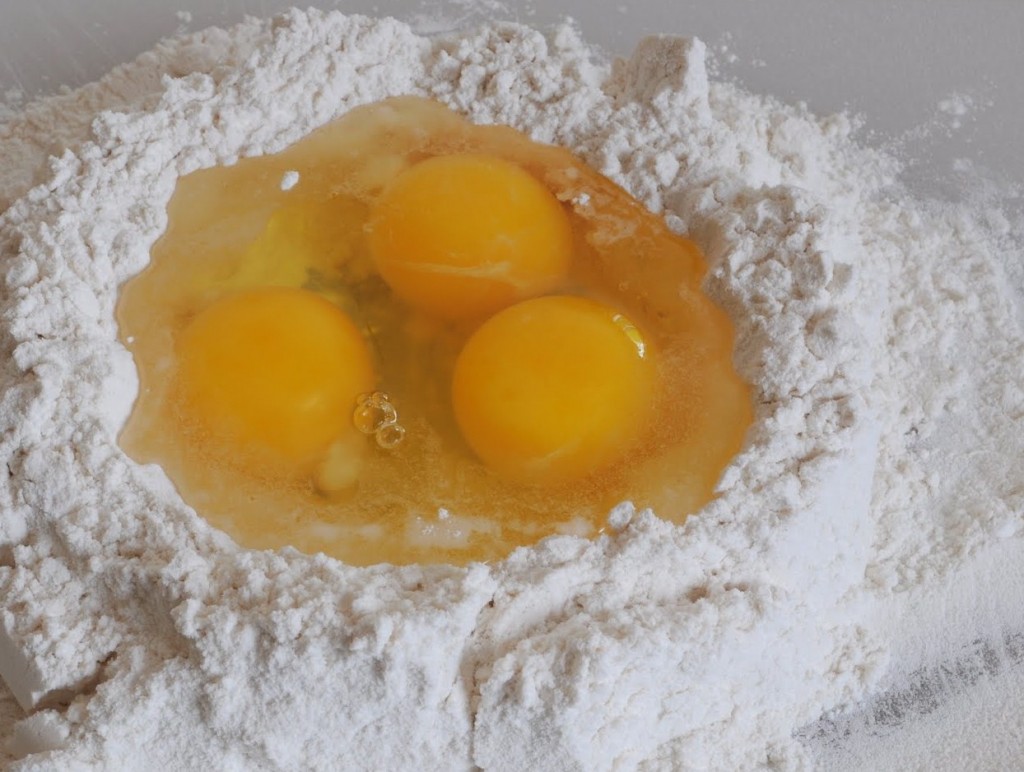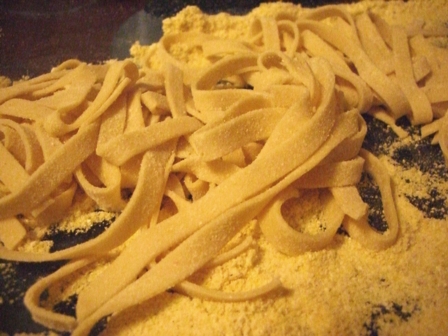You’d be absolutely shocked at the amount of people who have never actually had fresh pasta, but eat the dried out bagged stuff regularly. You can take a boring “filler meal” and turn it into a fantastic dinner with homemade fresh pasta.
Many homemade fresh pasta recipes require a machine. This one doesn’t. You will need a rolling pin, though.
Fresh Pasta Ingredients
The pasta itself only uses three ingredients, flour, eggs and salt. But you should also make a homemade pasta sauce or cheesy alfredo sauce. Going through the effort of making homemade pasta and then pairing it with Ragu is quite possibly one of the deadly sins.
Preparing Your Homemade Pasta
Place two pounds of flour onto a table or cutting board in a simple mound or pile. Use a fork to form a small well in the middle. Like you do with mashed potatoes and gravy.

Fill the mound with three eggs (raw, shell removed, obviously) and a teaspoon of salt.
Break the egg yolks with a fork and mix the eggs and salt together in the well without disturbing the flour too much.
Slowly mix flour into the egg mixture, do this gradually and gently, until the mixture is completely mixed into the flour.
Now roll the whole thing into a ball with your hands or a dough knife.
If the mixture is too dry to form a proper ball, add more egg. If it’s wet enough that it sticks to your fingers, gradually add a bit more flour.
Once it’s reached the proper consistency, you’re going to knead the dough. Gently flatten the ball and fold it over and knead together. Repeat several times or until the whole mixture is perfectly smooth. Generally this will take at least five minutes.
Now separate the dough into three smaller balls and let them sit under a towel for five to ten minutes. This will make the next steps more manageable.
Gently flatten the dough balls with your hands. You’re looking to get them down to about a quarter of an inch or so.
Now you can use these dough balls to make any sort of pasta, but without a machine or any special tools, the easiest option is fettuccine.
Now, roll out your dough. It’s important to not rush this part. You want to gently push the dough away from you while rolling to allow it to expand into a rectangular shape. The flattened dough will be growing larger as it gets thinner.
Once you’ve flattened it into a large rectangle of a reasonable thickness for eating (you’ve seen fettuccine before, right?) you’ll be cutting it into long strips. Now if you have a dough knife, this is fairly easy. Without one, you’ll want to use the longest knife you have and just be very deliberate and slow about cutting.

Once cut, it’s ideal to hang them to prevent it from sticking together, but if no option for hanging is available you can just lay it flat on a towel.
Tips for Making Your Own Fresh Pasta
Make your fresh pasta a few times before you give up on it. It gets easier and quicker every time. Practice, and all that.
Once you’ve mastered fettuccine it’s fairly obvious how to make most other kinds of pasta. Don’t be afraid to experiment.
Fresh pasta generally only lasts about a week, so don’t make more than you plan on eating. Just make it more often.
Would you happen to know about how many cups of flour are per pound? How much pasta does this recipe make?